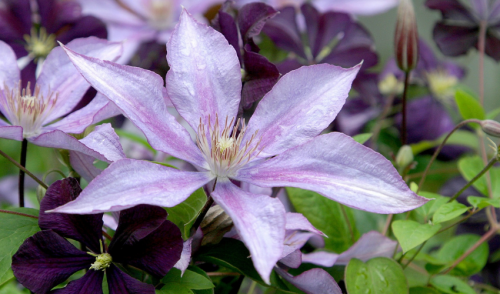
Winter your Clematis
Clematis are one of the easiest flowering vines to grow if you follow a few simple rules! They come in a wide assortment of varieties, shapes and sizes, and are one of my favorite flowers for summer long color.
First thing to remember is that clematis is another shallowly rooted plant, so it needs a good loamy, loose soil, with plenty of air space for those developing roots. Heavy clay or gumbo type soils will stunt the growth and they will not thrive. I recommend adding gypsum to break up heavy soils, followed by mixing in compost around the root systems. You can also do a fall application of an organic fertilizer, the one we love is called Plant Tone. Stay away from fertilizers with high nitrogen, we want to apply those with more minerals to build root systems.
In order to get great flowers, the clematis need to have their heads in the sun! Since they are shallowly rooted, their feet need to be in the shade, which means a good layer of mulch, or other plants shading the root system. This is especially important in the winter months, a good layer of compost will help keep them from trying to start to grow during warm early spring/winter days.
You're going to get tired of my preaching on the watering topic for fall, but it's probably one of the most important winter factors for not only clematis, but all your plants in the yard. We recommend at least 1 inch of water per week until the ground freezes (not air temperature), so keep on watering as long as it is still being absorbed. Again, a good layer of compost or mulch will keep that moisture in the ground. Most winter losses of plants occur because they simply dry out!
Pruning is a topic that has many opinions, but I will tell you what I do with my clematis in the winter. There are all sorts of recommendations on the Internet depending on what type of clematis you have. Most of the varieties that we sell are summer blooming. I usually just leave the plants alone, not doing any pruning in the fall. I like to leave the tops intact, helps to protect the vine in case we have an open winter. In early spring while the plants are still dormant (usually mid to end of April), I will cut them back hard to about 24". This might seem quite severe, but my experience has shown that this encourages a lot of new growth on the vines and even more summer blossoms.

